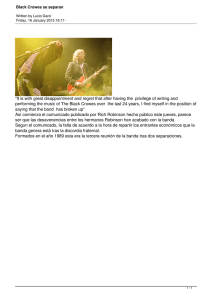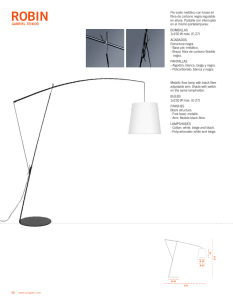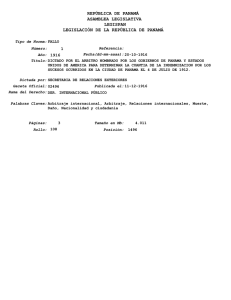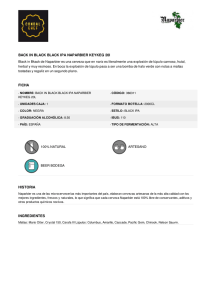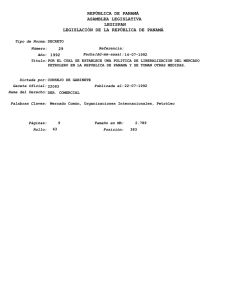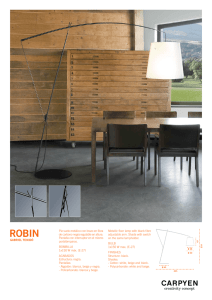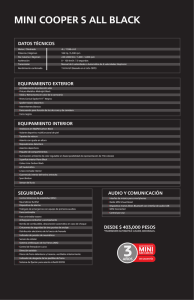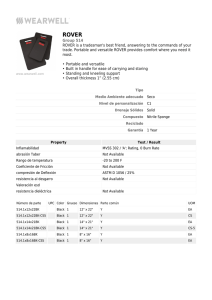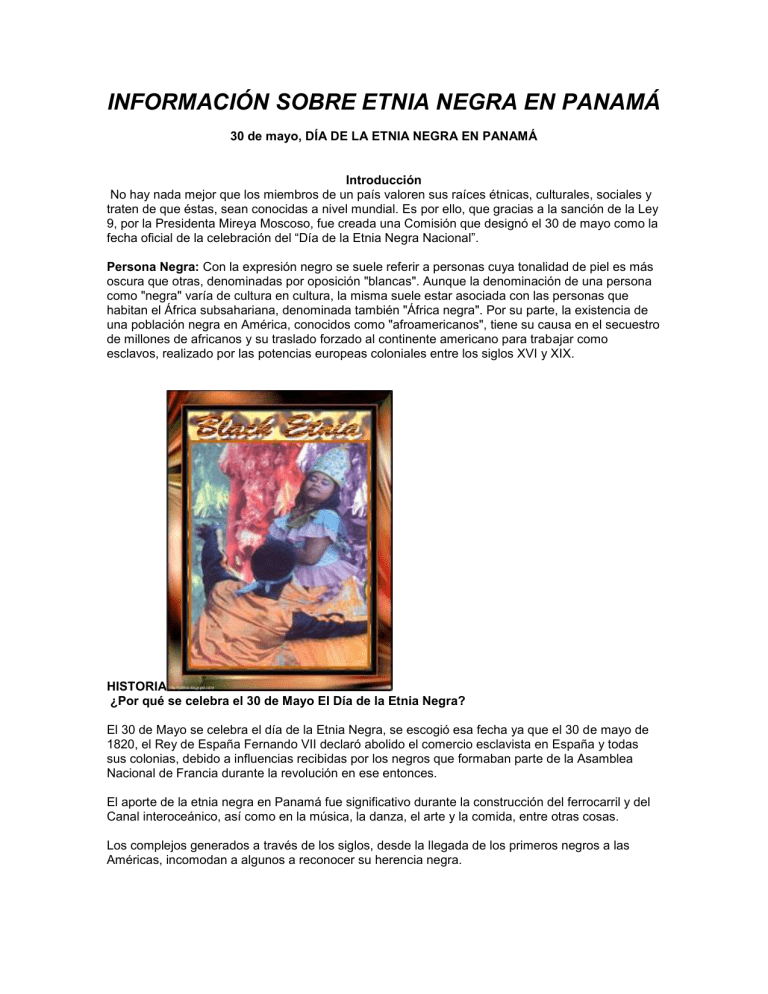
INFORMACIÓN SOBRE ETNIA NEGRA EN PANAMÁ 30 de mayo, DÍA DE LA ETNIA NEGRA EN PANAMÁ Introducción No hay nada mejor que los miembros de un país valoren sus raíces étnicas, culturales, sociales y traten de que éstas, sean conocidas a nivel mundial. Es por ello, que gracias a la sanción de la Ley 9, por la Presidenta Mireya Moscoso, fue creada una Comisión que designó el 30 de mayo como la fecha oficial de la celebración del “Día de la Etnia Negra Nacional”. Persona Negra: Con la expresión negro se suele referir a personas cuya tonalidad de piel es más oscura que otras, denominadas por oposición "blancas". Aunque la denominación de una persona como "negra" varía de cultura en cultura, la misma suele estar asociada con las personas que habitan el África subsahariana, denominada también "África negra". Por su parte, la existencia de una población negra en América, conocidos como "afroamericanos", tiene su causa en el secuestro de millones de africanos y su traslado forzado al continente americano para trabajar como esclavos, realizado por las potencias europeas coloniales entre los siglos XVI y XIX. HISTORIA ¿Por qué se celebra el 30 de Mayo El Día de la Etnia Negra? El 30 de Mayo se celebra el día de la Etnia Negra, se escogió esa fecha ya que el 30 de mayo de 1820, el Rey de España Fernando VII declaró abolido el comercio esclavista en España y todas sus colonias, debido a influencias recibidas por los negros que formaban parte de la Asamblea Nacional de Francia durante la revolución en ese entonces. El aporte de la etnia negra en Panamá fue significativo durante la construcción del ferrocarril y del Canal interoceánico, así como en la música, la danza, el arte y la comida, entre otras cosas. Los complejos generados a través de los siglos, desde la llegada de los primeros negros a las Américas, incomodan a algunos a reconocer su herencia negra. No fue hasta el año 1932 que los negros causaron impacto en la política, cuando pudieron votar en las elecciones donde ganó Harmodio Arias en 1932. No obstante, se intentó impugnar las elecciones alegando que los ascendientes antillanos no eran panameños. Hoy no hay distinción entre el electorado y tampoco en los puestos públicos. --> La etnia negra en Panamá, en especial los descendientes de los afroantillanos que llegaron hace ya 120 años al Istmo con la construcción del canal francés, ha aportado grandemente a la cultura e idiosincrasia del panameño. Los pobladores negros que desde los primeros años se trajeron de sus tierras africanas, a pesar de la injusticia que motivó su presencia en América, también contribuyeron notablemente a la formación del Nuevo Mundo, y su huella se manifiesta decisivamente en los pueblos americanos, en especial en el área del Caribe. El valioso aporte de los esclavos africanos, negros y mulatos libres al desarrollo de la vida colonial en el Istmo de Panamá es importante. Este aporte no es motivo de orgullo para los panameños de ascendencia africana, porque fue forzado, doloroso, cruel e inhumano, por la separación de familias, el abuso a los niños en todos los trabajos esclavizados, la nutrición paupérrima, los barracones miserables, los azotes con látigos, los cepos, las mutilaciones, los ahorcamientos. Los esclavos africanos fueron la principal mano de obra en las exploraciones en Darién, las construcciones en Nombre de Dios, Portobelo, Natá, Santiago, Parita, Tonosí, Los Santos, Montijo, Antón, Penonomé, Chorrera, Remedios, Soná, La Palma en Las Tablas y, sobre todo, en la Muy Noble y Muy Leal Ciudad de Panamá: las fortalezas, los puertos, los edificios administrativos del gobierno colonial, los conventos, las iglesias, las minas, los aserraderos, y como conductores de recuas de mulas, como de buzos en las pesquerías de perlas, en la agricultura, los hatos de ganado, la milicia y, también, en los cañaverales e ingenios de azúcar BAILE DE LA ETNIA NEGRA EN PANAMÁ --> En Latinoamérica, la música folclórica panameña se destaca por sus danzas, movimientos de manos, pies y cadera, y, sobre todo, los ritmos alegres de sus tambores: ritmos sonoramente marcados por la herencia africana. Es una de las manifestaciones folclóricas más distintivas y coloridas de la provincia de Colón. La tradición del baile congo surgió en la costa atlántica, tras las fugas de los negros traídos por los colonizadores europeos. (mas informacion sobre le Baile Congo) IDIOMA DE LA ETNIA NEGRA EN PANAMÁ: Para comunicarse entre ellos una mezcla de español, inglés y francés, y también hablan al revés. Los europeos trajeron los primeros esclavos al nuevo continente "Con ellos llegó una nueva estructura cultural llena de ritmo y sensualidad, pues llevaban la música del tambor en la sangre y la utilizaban como medio de expresión". A mediados del siglo XV algunos negros, provenientes en su mayoría de las naciones africanas de Guinea y Congo, se sublevaron y se refugiaron en la selva caribeña. Se les conoció como cimarrones (esclavos prófugos, rebeldes) y desde sus emplazamientos o aldeas utilizaban el tambor para poder comunicarse con sus hermanos en cautiverio. "Otro medio de expresión utilizado por los negros de aquella época y que aún practican los grupos congos es el saludo con los pies y el hablar en revecina, una mezcla del francés, portugués y castellano o hablar al revés". Durante la colonia, tanto el negro esclavo como el cimarrón se reunían en los palenques para realizar su danza o juego congo, donde a través de la música y el baile recordaban sus orígenes, exteriorizaban su solidaridad, su nostalgia y su odio hacia el blanco opresor. "También era una manera de burlarse de la estructura eclesial de la época que les decía que si no obedecían al amo, se los llevaba el diablo. Por eso, la personificación de las ánimas y el diablo en el bautizo congo", explica. El baile congo se realiza con los pies descalzos, como símbolo de la relación del negro con la tierra. Los personajes principales del juego congo son la reina, el rey o Juan de Dios, el pajarito y las mininas, mientras que como personajes secundarios aparecen las ánimas, el diablo y el holandés o el gallego, los cuales representan la lucha permanente entre el bien y el mal. El baile congo conserva el orgullo del ser negro y a través de la música, la cultura y la tradición busca acabar con las diferencias étnicas y unirnos en una sola nación. --> LENGUAJE DE LA ETNIA NEGRA EN PANAMÁ En el habla de los panameños se encuentran huellas de palabras que tienen su origen en lenguas africanas: bemba, bullerengue, bunde, burundanga, cabanga, cachimba, chéchere, congo, cumbia, dengue, guineo, guandú, motete, ñame, quilombo... Llaman poderosamente la atención los estudios de destacados lingüistas panameños y extranjeros en el habla de los negros congos de Panamá, uno de los "criptolectos afrohispánicos" más documentados por su esencia de inversiones semánticas, juegos de palabras, deformaciones jocosas e improvisación ritualizada. Las huellas de dichos aportes en el español panameño se pueden observar en el siguiente párrafo: Vecina, yo no soy vidajena, y no me gusta esa vaina de revulú, pero te voy a contar un bochinche bajo una condición: no quiero burundanga ni mucho menos wapí, pero si me das de comer un poco de chicheme, concolón, carimañola, sancocho y mondongo, y también si escucho música chévere de congo, cumbia, saracundé y calipsó. Ese man flacuchento y ñato vestido de guayabana azul y sombrero montuno que viene allí, la abuela es una martiniqueña frenchí que habla patuá y a él le dicen Flacobala. Pues, él era mi cacique, pero ahora es mi pasiero. Su motete ya no tiene ñame, guineo ni guandú. Lo que tiene es un pocotón de chécheres. Según la comadre fula radiobemba, el cambio en ese laopé no se debe a un macuá ni al quenque, porque el man no es canyacero ni tiene vicios de fumador, y no es un alelado. Pero el cambio sí se debe a la tremenda cabanga por no ver a la gial que es norsa en el hospital Santo Tomás. Ella es la misma enfermera que cuida mi chichí y tu chiquilín. Sí, ¡ombe!, la gial que es reina del bullerengue, bambasú y del bunde. La mamá es de Garachiné, allá en Darién, y el papá es el man que come mucho patacón, patí y domplín, y parece yumeca, pero es buchí de Río Hato o Penonomé. El man no es ni cocobolo ni calungo porque tiene el pelo cuzcú acholado. Sí, el mismo señor que no es pilinque y ayer te regaló un cuara de propina después de comprar en ganga la hamaca, la cadena chata y la cachimba. Pues, es verdad, ese man no es camaján, es un pulpo con camarón aquí y allá de día, y, hasta por la noche, werkea de guachimán. En el vocabulario que las Congas emplean en sus cantos, podrá notarse el uso, frecuentemente de muchas palabras que sufren transformaciones y de las cuales nadie se asombra al escucharlas, debido a que estamos acostumbrados a obsevar este fenómeno en el lenguaje de muchas personas cultas. De esta manera, se ha generalizado el uso de "Dio" por Dios. La preposición PARA presenta el caso más concreto, Nadie dentro del folk, dice para sino pa. Así es corriente el uso de: pa, por para; pa'l, por para el; pa'tras, por para atrás; na', por nada; pa' cá, por para acá; pa'rriba, por para arriba. Algunas palabras tambien pierden sus sonidos finales: ver - ve; cantar - cantá; mujer - mujé; remediar - remediá; y así detrá, caridá, rompé, madrugá,como se pierden también sonidos iniciales: naguas, lacena, costá, tuve, por enaguas, alacena, acostar, estuve. Los que más sufren son los plurales en los casos de concordancia: las muchacha; los hombre; tus labio; tres golpe; estos tambore; somos iguale: Así como casos de prótesis: ajumada, por jumadas; alevántate, por levántate; emprestar, por prestar. Cambios de acento: dejá, por deja; subite, por súbete; mandale, por mándale. COMIDA DE LA ETNIA NEGRA EN PANAMÁ --> LA COMIDA FAVORITA EN LA ETNIA PANAMEÑA, Y MUCHO MAS EN NUESTRO COLÓN ¡Mmmm...! el aroma del saus, del pescado en escabeche, del arroz con guandú y coco y, por supuesto, del bon. Bón, Bun El "bón" que tanto disfrutamos, especialmente durante la Semana Santa, se originó en el Siglo XIV en Inglaterra, donde un sacerdote comenzó a hornearlos para dárselos a los pobres. Poco tiempo después, se conocieron como los "panes de la cruz roja" y eran degustados por todos, especialmente el viernes santo. Estos panes de levadura y especies se hacen con pasitas, pasas de corinto, y cáscara de cítricos confitadas, y se decoran por encima con una cruz sobre su brillante superficie tostada. La tradición del bón cruzó los mares durante el comercio de los esclavos y fue adoptada por los antillanos, costumbre que ha perdurado hasta nuestros días. Un buen bón es pesado y denso. Se requiere amasar y reposar y amasar nuevamente hasta adquirir la consistencia apropiada. No es un pan dulce como suelen decir algunas personas. Otras Comidas Saus, Souce Enyucado Cou Cou Saril, Sarril Guandú, Gongo Peas Pescado en Escabeche --> Al recorrer un día domingo por los caseríos de nuestra ciudad se impregna en nuestros sentidos en aroma del arroz con coco, la sazón de la gallina peculiar de Colón, es inevitable detenerse por lo especial que nos produce estos olores de nuestra comida colonense. Comidas de la Provincia de Colón Saus, Souce 4lbs.patitas de puerco 1bot. vinagre 16oz 10 limónes 3 aji chombo (irish bonnet) sal a gusto 2lbs. pepino 1 1/2 cebolla Preparación Limpiar las patitas con una navaja para quitarles todos los pelitos, ponerlas en agua hasta que hiervan, enjuagarlas y ponerlas a cocinar en agua con sal y ajo hasta que ablanden a gusto. Preparar la vinagreta: en un recipiente de vidrio, mezclar el pepino en rodaja, la cebolla en rodaja, exprimirles los limones, agregarle el vinagre, el ají chombo partido en 4, probarle el punto de sal dejarlos por 1hora hasta que cojan gusto. Finalmente agregar las patitas y dejarlas a temperatura ambiente mínimo 3 horas hasta el momento de servir. Enyucado 3lbs. yuca 1 coco mediano 4 tazas de azucar morena 1 taza de pasitas 1pqt. de canela en polvo 2 cucharadita de vainilla Preparación Ralle el coco y añadale agua para separar la leche del afrecho. Luego cuele el afrecho y ponga la leche en un recipiente. Ralle la yuca en otro recipiente mediano, añadale la leche de coco, batir por unos 10 -15 minutos, añada la vainilla, el azúcar, la canela. Batir por 20 minutos, luego agregue las pasitas y bata por 15 minutos. Poner la mezcla en una mandeja de hornear previamente engrasada y hornee por 1 1/2 hora, a una temperatura de 350 grados. Servir a temperatura ambiente. Cou Cou 2 tazas de harina de maíz 1doz de ñajú, cortando en rodajas, quitandole la parte superior. 6 tazas de agua 1 cucharadita de sal 2 cucharaditas de mantequilla Preparación Limpie los ñajú y corte en rodaja, cocine en la mitad del agua con sal a gusto por 5 minutos. Mezcle el agua restante con la harina de maíz, mezcle bien y agregue a la olla de ñajú. Deje hervir a fuego lento, revolviendo constantemente, para evitar que se empelote. Siga revolviendo y cocinando hasta que la harina de maíz se cocine, suave y espesa. Agregue la mantequilla y sal al gusto y sirva caliente. Arroz con Guandú Frijól muy oloroso al cocinar. Se prepara con arroz y leche de coco( una comida muy exquisita) o arroz con guando simplemente. Acompaña con bacalao, gallina, carne o puerco. Saril, Sarril Saril (rojo o blanco) jengibre agua Preparación Seleccione el saril, remueva los pétalos, lave en un recipiente de porcelana o cerámica. Prepare el agua con jengibre, canela y clavito de olor, ponga a hervir por 15 minutos. Luego añada el agua hirviendo al recipiente con los petalos y deje en reposo hasta que el agua se tiña de rojo. Se cuela, se endulza y se enfria. A muchas personas les gusta caliente como té.. Pescado en Escabeche 3lbs. sierra o cojinua 2lbs. de cebolla 2 aji chombo Sal al gusto 1cdta. pimienta (black pepper) 10granos de pimienta dulce Curry 1 taza vinagre blanco 1 taza de agua Preparación Se limpia el pescado, se corta en pedazos, se condimenta con la sal al gusto, pimienta y curry. En una sarten bien caliente con bastante aceite, se frien las presas de pescado. El sofrito: Se cortan las cebollas en rodajas, se corta cada ají en 4 pedazos, en una sarten con poco aceite caliente, se sofrie la cebolla con el ají y pimienta dulce. Agregar una pisca de curry para dar color, y el vinagre con el agua. En un recipiente de vidrio, coloque las presas de pezcado, luego viertale el sofrito. Tapar por 1 hora. Se sirve caliente o a temperatura ambiente. VESTIMENTA DE LA ETNIA NEGRA EN PANAMÁ --> Vestidos de la Etnia Negra Los vestidos de los congos están llenos de colorido. Las mujeres utilizan una pollera de dos piezas, una camisa con arandina y un pollerón hecho de retazos. Los hombres utilizan la ropa al revés, un sombrero de estopa de coco adornado con plumas, conchas, espejos o cuentas y se pintan la cara con carbón. La moda ‘afro’ es más que las polleras coloridas que se aprecian cuando se realizan presentaciones de danza entre los negros congos y diablitos. Esa vestimenta, en la que la mujer usa una falda de vuelo elaborada con retazos de tela y el hombre se coloca un atuendo viejo, rasgado y al revés, son sólo los vestidos típicos de la etnia, como sería la pollera y el montuno para los santeños. Esta moda es poco conocida en el país, porque los mismos afrodescendientes no la dan a conocer. Asegura que pocos son los que llevan estos vestidos con orgullo por las calles; los demás, mandan a confeccionarlos para asistir a las iglesias afropanameñas, o para festejos especiales como el Día de la Etnia Negra, el cual se celebra el 30 de mayo. Esta moda, que es rica en historia, transmite la esencia de la selva, la densidad y vistosidad de sus bosques, así como la fuerza de los animales más feroces e inteligentes, como los tigres. Hay dos estilos. El de las Antillas, que se caracteriza por elaborarse con telas llenas de colores fuertes como el azul, el amarillo y el naranja. Y el de África, mas se inclina por los colores tierra y ocres, acompañados con diseño en henequén y paja. Ahora, el toque del vestuario lo da, según el diseñador, los adornos que se llevan en la cabeza. En las mujeres es muy conocido el ovana o rap que son las telas que cubren todo o parte del cabello."Hay diferentes formas de envolver la cabeza para crear múltiples diseños, pero son técnicas que se aprenden. No cualquiera puede hacer que un simple trapo se vea elegante y vistoso". En los hombres, es más común el kufi, gorrito elaborado con tela y pelón. REPÚBLICA DE PANAMÁ MINISTERIO DE LA PRESIDENCIA DECRETO EJECUTIVO No. 124 (de 27 de mayo de 2005) "Por el cual se crea la Comisión Especial para el establecimiento de una política gubernamental para la inclusión plena de la etnia negra panameña" Dado en la ciudad de Panamá, a los veintisiete días del mes de mayo de dos mil cinco (2005). El Día Nacional de la Etnia Negra, Mireya Moscoso Viernes, 31 de mayo de 2002. La Licda. Eunice Meneses Araúz., Secretaria Ejecutiva de la Comisión Coordinadora de la Etnia Negra Panameña, en un informe titulado "ASÍ NACIÓ NUESTRO DÍA" comunicó: "El gobierno nacional, mediante Ley No. 9 de 30 de mayo de 2000, estableció el Día de la Etnia Negra Nacional. La idea originaria en torno a la creación de una ley para este efecto nació de la inspiración y acertada visión de un hijo de la Provincia de Chiriquí, específicamente, de Las Arenas de Puerto Armuelles. Se trata del Honorable Claral Richards, un afropanameño entre cuyos logros personales se destaca haber sido campeón nacional de lanzamiento de disco durante los Iros. Juegos Nacionales del año 1955 y representar a la República de Panamá, como lanzador estrella de béisbol habiendo, incluso, firmado contrato con los Gigantes de San Francisco, como jugador de las ligas menores profesionales. Este destacado atleta hasta la fecha de su jubilación, fue supervisor en la United Fruit Co. --> El aporte a la literatura panameña DE LA ETNIA NEGRA EN PANAMÁ En la literatura panameña hay importantes aportes de escritores de la etnia negra. Por ejemplo, se destaca el poeta modernista Gaspar Octavio Hernández (18931918). El eminente crítico literario, Rodrigo Miró Grimaldo, en un estudio escribió: "Su poesía es esencialmente musical, y tiende a eludir la realidad... Con todo, su obra constituye unos de los más importantes logros de la poesía panameña"(Miró 1974: 289). Gaspar Octavio Hernández fue uno de los primeros patriotas en presentar la inquietud por la soberanía ultrajada, consecuencia del concepto "a perpetuidad" en el Tratado Hay-Bunau Varilla del año 1903. En el poema "A Panamá", Gaspar Octavio Hernández expresó con fervor patriótico: Cíñete casco de adalid! Entona no himnos de paz sino canción guerrera que derrame su música altanera con estruendo marcial, de zona en zona. ¡Oh emperatriz y sin corona! DÍA DEL AFRODESCENDIENTE EN OTRAS LATITUDES USA - Black history month, febrero. Venezuela - Mes de la afrovenezolanidad, mayo Colombia - Día de la Afro-colombianidad, 21 de mayo. Panamá - Día de la Etnia Negra de Panamá, 30 de mayo Peru - Día de la Cultura Afro-peruana, 4 de junio. Costa Rica - Día de la Cultura Afro-costarricense, 31 de agosto. Uruguay - Día del Patrimonio, cualquier sábado de septiembre Ecuador - Primer domingo de octubre. Conclusión El día de la Etnia negra en Panamá tendrá enorme potencial cuando las comunidades negras reconozcan sus posibilidades y se alejen de la aprehensión a su negritud. Debemos comprender que no hay otro momento más oportuno, para que se destaquen los logros del hombre negro en Panamá y su participación en la formación de la nación y nuestra nacionalidad. Debemos aprovecharnos del día y más que nada del mes para exprimir cada onza de utilidad disponible, promoviendo y educando. Bibliografía http://yolitas.blogspot.com http://www.sertv.gob.pa/ http://es.wikipedia.org/ http://diadelaetnia.homestead.com/receta.html INFORMATION ABOUT BLACK ETHNIC GROUP IN PANAMA 30 may, day of the ethnic black in PANAMA Introduction There is nothing better that members of a country value their ethnic, cultural and social roots and try these, are known around the world. That is why, thanks to the passage of the law 9 by President Mireya Moscoso, was created a Commission designated may 30 as the official date of the celebration of the "day of the ethnic black national". Black person: With black expression is usually refer to people whose skin tone is darker than others, called "white" opposition. Although the designation of a person as "black" varies from culture in culture, it is often associated with people living in sub-Saharan Africa, also referred to as "Black Africa". Moreover, the existence of a black in America, known as "African-Americans", population has its cause in the kidnapping of millions of Africans and their transfer forced to the Americas to work as slaves, performed by the European powers in colonial between centuries XVI and XIX. HISTORY Why is it celebrated on May 30 the day of the black ethnic group? May 30 he is celebrated the day of the black ethnic group, that date was chosen since May 30, 1820, King Fernando VII of España declared abolished the slave trade in Spain and all its colonies, due to influences received by blacks who were part of the National Assembly of France during the revolution at the time. The contribution of the black ethnic group in Panama was significant during the construction of the railroad and the Panama Canal, as well as music, dance, art and food, among other things. The resorts generated through the centuries, since the arrival of the first blacks to the Americas, bother some to recognize his black heritage. It was not until 1932 that blacks caused impact in politics, when they could vote in the election where he won Harmodio Arias in 1932. However, attempted to challenge elections alleging that Antilles ascendants were Panamanians. Today there is no distinction between the electorate and neither in public positions. --> The black ethnic group in Panama, especially the descendants of the afroantillanos who came 120 years ago the isthmus with the construction of the French channel, has contributed greatly to the culture and idiosyncrasy of the Panamanian. Black residents who brought their African land, despite the injustice that motivated his presence in America, from the early years have also contributed significantly to the formation of the new world, and their mark manifests itself decisively in the American peoples, especially in the area of the Caribbean. The valuable contribution of the African, black and mulatto slaves free to the development of colonial life in the isthmus of Panama is important. This contribution is not source of pride for African descent Panamanians, because it was forced, painful, cruel and inhuman treatment, the separation of families, the abuse of children in all the enslaved work, poor nutrition, the squalid barracks, the lashes with whips, traps, mutilation, hangings. African slaves were leading labour in explorations in Darien, the buildings in Nombre de Dios, Portobelo, cream, Santiago, Parita, Tonosi, Los Santos, Montijo, Anton, Penonome, Chorrera, remedies, Sona, La Palma in Las Tablas and, above all, The very Noble and very loyal city of Panama: the strengths, the ports, the administration of the colonial government buildings , the convents, the churches, mines, sawmills, and as drivers of Mule trains, as divers in Pearl fisheries, agriculture, herds of cattle, the militia and, also, the cane and sugar refineries Dance Ethnic black in PANAMA --> In Latin America, the Panamanian folk music stands out for dances, movements of hands, feet, and hip, and, above all, the joyful rhythms of drums: beats loudly marked by the African heritage. It is one of the most distinctive and colorful of the province of Colón folkloric. Congo dance tradition arose on the Atlantic coast, after leaks of blacks brought by European settlers. (more information about le Congo dance) Language LA ETNIA NEGRA in PANAMA: to communicate between them a mixture of Spanish, English and French, and also speak backwards. The Europeans brought the first slaves to the new continent "With them came a new cultural structure full of rhythm and sensuality, because they carried the music of the drum in the blood and used it as a medium of expression". In the middle of the 15th century some blacks, mostly from the African Nations of Congo and Guinea, revolted and took refuge in the Caribbean rainforest. Met as Maroons (refugees, rebel slaves) and from their sites or villages used the drum to be able to communicate with their brethren in captivity. "Other means of expression used by blacks of that era and that they still practice the groups howler is greeting with feet and speaking in revecina, a mixture of French, Portuguese and Spanish or speak backwards." During colonial times, both the black slave and the cimarron gathered in the palenques to perform their dance or play congo, where through music and dance remembered its origins, exteriorizaban solidarity, his nostalgia and his hatred for the white oppressor. "It was also a way of mocking the ecclesial structure of the era that told them that if they were not due to the master, the devil took them is. For that, the personification of las animas and the devil in the congo christening", explains. Congo dance is performed with bare feet, as a symbol of the black relationship with the Earth. The main congo game characters are Queen, King or Juan de Dios, the bird and the teens, while as secondary characters appear souls, the devil and the Dutch or Galician, which represent the permanent struggle between good and evil. Congo dance retains the pride of being black and through the music, culture and tradition seeks to put an end to ethnic differences and unite in one nation. --> Language Ethnic black in PANAMA In the speech of the Panamanians are traces of words which have their origin in African languages: bemba, bullerengue, bünde, burundanga, cabanga, Hookah, chechere, congo, cumbia, dengue, banana, guandu, motet, name, quilombo... They powerfully draw attention to studies of prominent Panamanian linguists and foreign in the speech of the black congos of Panama, one of the "criptolectos afrohispanicos" more documented their essence of semantic investments, puns, humorous deformation and ritualized improvisation. Traces of such contributions in the Panamanian Spanish may be seen in the following paragraph: Neighbour, I am not vidajena, and I don't like the revulu pod, but I'll tell a commotion under a condition: do not want burundanga and much less wapi, but if I eat some chichime, concolon, carimañola, sancocho, and mondongo (tripe), and also if I listen to cool music of congo, cumbia, saracunde and Calypso. That man flacuchento and nato dress blue cultive and montuno hat that comes there, Grandma is a martiniquena frenchi patua-speaking and to tell Flacobala. Therefore, he was my Chief, but now is my pasiero. His Motet has no name, banana, or pigeon. What you have is a bunch of stuff. According to the comadre fula radiobemba, change in that laope is not a macua nor to the quenque, because the man is not canyacero nor has vices of smoking, and is not an alelado. But the change is Yes due to the tremendous cabanga to not see the gial's norsa hospital Santo Tomás. She is the same nurse who cares for my chichi and your boy. Yes, ombe!, the gial who is Queen of the bullerengue, bambasu and bunde. Garachine, in Darien, is MOM and dad is the a man who eats much patacón, pati and domplin, and seems yumeca, but is buchi Rio Hato of Penonome. The man is not or cocobolo and calungo because it has hair acholado Faculdade cuzcu. Yes, the same Lord who is not pilinque and yesterday gave you a tip cuara after buy bargain hammock, flat chain and hookah. Therefore, it is true, that man is not camajan, is an octopus with shrimp here and there day and even at night, guachiman werkea. Vocabulary Congas used in their songs, may note the use, often of many words that undergo transformations and of which no one is surprised to hear them, because of that we are accustomed to see this phenomenon in the language of many educated people. In this way, the use of "Dio" is widespread by God. The preposition to presents the more specific case, no one within folk, he says but pa . So is the use of power: pa, by; PA'l, for to him; PA'tras, for back; NA', for nothing; PA' ca, for here; PA'rriba, by up. Some words also lost their final sounds: see - looks; Sing - Sing; female - female; remedy - remedia; and well behind, carida, break, dawn, as initial sounds are also lost: naguas, soon, costa, had, by petticoats, cupboard, bed, I was. Those who suffer most are the plural in cases of concordance: the girl; the man; your lip; three coup; These reel; We are equal: As well as cases of prosthesis: ajumada, by jumadas; peerles, by waking up; Emprestar, for lending. Changes of accent: déjà, by leave; Subite, by hop; mandale, by sending him. Food Ethnic black in PANAMA --> Favorite food Ethnic PANAMANIAN, and much more in our COLON Mmmm...! the aroma of the saus, of fish in marinade, rice with Pigeon and coconut and, of course, Bon. Bon, Bun The "bon" that we both enjoy, especially during Easter, originated in the 14th century in England, where a priest began to bake them to give them to the poor. Shortly afterwards, they met as "breads of the Red Cross" and they were tasted by everyone, especially the Holy Friday. These species and yeast breads are made with raisins, raisins, currants and candied citrus peel, and are decorated on top with a cross on its bright toasted surface. The tradition of the bon crossed the seas during the slave trade and was adopted by the West Indians, custom that has lasted until today. A good bon is heavy and dense. Required kneading and rest and knead again until the proper consistency. It is not a sweet bread as some people say. Other meals Saus, Souce Enyucado Cou Cou Saril, Sarril Guandu, Gong Peas Pickled fish --> Go one day to Sunday by the hamlets of our city pervades our senses in aroma of rice with coconut, then of the peculiar goose of Columbus, is inevitable to stop for something special that makes us our colon food odours. Food of the province of Colón Saus, Souce 4lbs.patitas pork 1bot. vinegar 16oz 10 lemons 3 aji chombo (irish bonnet) salt to taste 2 lbs. cucumber 1 1/2 onion Preparation Clean the feet with a razor to remove all hairs, put them in water until boiling, rinse and put them to cook in water with salt and garlic until tender to taste. Prepare the vinaigrette: in a glass container, mix the cucumber slice, slice onion, squeeze them lemons, add vinegar, aji chombo split into 4, salt prove leave them for 1 hour until they pick up taste. Finally add the legs and leave them at room temperature at least 3 hours until serving time. Enyucado 3 lbs. cassava 1 medium coconut 4 cups of brown sugar 1 cup of raisins 1pqt. of cinnamon powder 2 tsp. vanilla Preparation Grate coconut and add water to separate the bran milk. Then strain the bran and put the milk in a bowl. Grate the cassava in another medium bowl, add the coconut milk, beat by about 10 - 15 minutes, add the vanilla, sugar and cinnamon. Beat for 20 minutes, then add the raisins and whisk for 15 minutes. Put the mixture in a previously greased baking tray and bake for 1 1/2 hours, at a temperature of 350 degrees. Serve at room temperature. Cou Cou 2 cups corn flour remove top 1doz naju, cutting into slices. 6 cups water 1 teaspoon salt 2 teaspoons butter Preparation Clean the naju and cut into slice, Cook in half the water with salt to taste for 5 minutes. Mix the corn flour with remaining water, mix well and add to the pot of naju. Let simmer, stirring constantly, to prevent it to empelote. Continue stirring and cooking until corn flour is cooked, soft and thick. Add the butter and salt to taste and serve hot. Rice with Pigeon Very fragrant cooking beans. It is prepared with rice and coconut (a very exquisite meal) milk or rice with Divisional simply. Accompanied by cod, chicken, beef or pork. Saril, Sarril Saril (red or white) Ginger water Preparation Select the saril, remove the petals, wash in a porcelain or ceramic container. Prepare water with ginger, cinnamon and Brad of odor, boil for 15 minutes. Then add the water boiling to the vessel with the petals and allow to rest until the water stain in red. It slips, it sweetens and be cool. Many people like hot tea... Pickled fish 3 lbs. sierra or cojinúa Onion 2 lbs. 2 aji chombo Salt to taste 1cdta. Pepper (black pepper) 10granos of sweet pepper Curry 1 cup white vinegar 1 cup water Preparation Cleaned the fish, cut into pieces, seasoned with salt to taste, pepper and curry. In a hot skillet with enough oil, is fried fish dams. Sofrito: cut onions in slices, cut each pepper into 4 pieces in a pan with some hot oil, will fry the onion with the red pepper and sweet pepper. Add a hint of curry to color, and the vinegar with water. In a glass bowl, place the prey of fish, then the sauce viertale. Cover for 1 hour. Served hot or at room temperature. Clothing Ethnic black in PANAMA --> The ethnic black dresses The congos dresses are full of colorful. The women used a two-piece skirt, a shirt with arandina and a pollerón made of scraps. The men used clothes backward, a hat adorned with feathers, shells, mirrors or accounts coir and paint the face with coal. The 'afro' fashion is more than colorful skirts appreciated when it is between the black monkeys and Devils dance performances. That dress, in which the woman uses a flying skirt made with scraps of fabric and the man stands an old, torn dress and upside down, they are just typical ethnic dresses, as it would be the skirt and the montuno for the santeños. This fashion is little known in the country, because same people of African descent do not give it to know. It ensures that few are those who carry these dresses proudly through the streets; others, sent to make them attend churches Panamanians, or for special celebrations like the day of The black ethnic group, which is celebrated on May 30. This trend, which is rich in history, conveys the essence of the jungle, density and flashiness of their forests, as well as the strength of the most fierce and smart, as the Tigers animals. There are two styles. The West Indies, which is characterized by elaborate fabrics full of strong as blue, yellow and orange colors. And of Africa, but it is inclined to the earth colors and ochre, accompanied with design in straw and sisal. Now, the touch of clothing gives it, according to the designer, the ornaments that are in the head. In women is well known the ovana or rap which are fabrics that cover all or part of your hair." There are different ways to wrap the head to create multiple designs, but they are technical that they learn. Not any can make a simple cloth look elegant and colorful". Kufi, Cap made with fabric and pelon is more common in men. REPUBLIC OF PANAMA Ministry of the Presidency Executive Decree No. 124 (of May 27, 2005) "That creates The Special Commission for the establishment of a Government policy for full inclusion the Panamanian black ethnic" Given in the city of Panama, at twenty-seven days of the month of May two thousand five (2005). The national day of The black ethnic group, Mireya Moscoso Friday, 31 May 2002. LDA. Eunice Meneses Araúz., Executive Secretary of The Coordinating Commission of The black ethnic Panamanian, in a report entitled "thus was born our day" reported: "The national Government, through law No. 9 of 30 May 2000, established the day of The black ethnic national." The original idea concerning the establishment of a law to this effect was born from the inspiration and vision of a son of the province of Chiriqui, specifically, from the sands of Puerto Armuelles. It is the Honourable Claral Richards, an afropanameno whose personal achievements stands have been national champion in discus during the go away. National Games of the year 1955 and represented the Republic of Panama, as baseball star pitcher, even signed with the San Francisco Giants, as a professional minor-league player. This outstanding athlete until the date of his retirement, was supervisor at The United Fruit Co. --> The contribution to the Panamanian literature Ethnic black in PANAMA There are important contributions from writers of the black ethnic group in Panamanian literature. For example, stands out the modernist poet Gaspar Octavio Hernández (1893-1918). The eminent literary critic, Rodrigo Miró Grimaldo, a study wrote: "his poetry is essentially musical, and tends to evade the reality... However, his work constitutes one of the most important achievements of the Panamanian poetry "(Miró 1974: 289)." Gaspar Octavio Hernández was one of the first Patriots to present concern for sovereignty outraged, consequence of the concept "in perpetuity" in the HayBunau Varilla Treaty from 1903. In the poem "A Panamá", Gaspar Octavio Hernández said with a patriotic fervor: Stick champion helmet! He sings No hymns of peace but Warrior song you spill your haughty music with martial noise, from zone to zone. Oh Empress and Crown! DAY OF THE AFRICAN DESCENT IN OTHER LATITUDES USA - Black history month, February. Venezuela -The afrovenezolanidad month, may Colombia - Day of the Afro-colombianidad, May 21. Panama -Day of The black ethnic group in Panama, May 30 Peru - Day of The Afro-peruana culture, June 4. Costa Rica - Afro-costarricense cultureday, August 31st. Uruguay- Heritage day, any Saturday in September Ecuador -First Sunday of October. Conclusion The day of the black ethnic group in Panama will have huge potential when the black communities to recognize their potential and move away from apprehension to his blackness. We must understand there is no other more appropriate time, so that Excel the achievements of the black man in Panama and its participation in the formation of the nation and our nationality. We must take advantage of the day and most of all month to squeeze every ounce of utility available, promoting and educating. Bibliography http://yolitas.blogspot.com http://www.sertv.gob.pa/ http://es.Wikipedia.org/ http://diadelaetnia.homestead.com/receta.html
